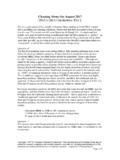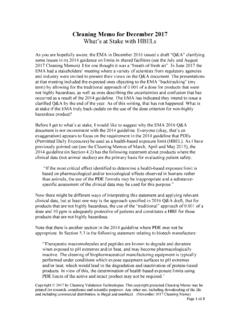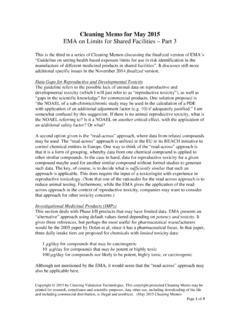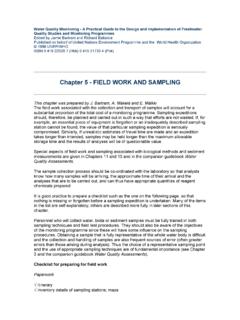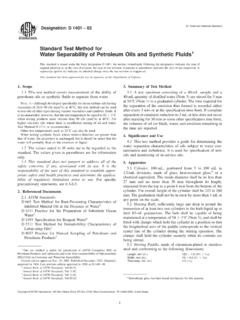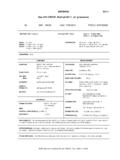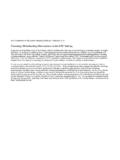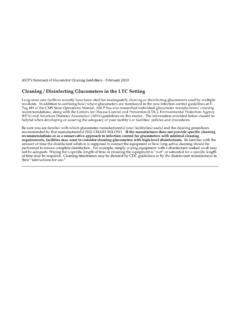Transcription of Systems-Based Inspections Describe cleaning …
1 cleaning Validation/LeBlanc/FDA DG 230 July 20, 201711 Systems-Based Inspectionsfor cleaning ValidationFDA DG 230 July 20, 2017 New Orleans, LADestin A. LeBlancCleaning Validation Describe cleaning processes andapproaches Identify various techniques utilizedto measure the effectiveness ofcleaning processes Identify documents associated withcleaning validation processes Identify significant issues and typicalproblems with cleaning validation3 cleaning Definition: The process ofremoving potential contaminantsfrom process equipment such thatthe equipment can be safely usedfor subsequent productmanufacture Focus for this presentation isprocess equipment, not cleanroomcleaning4 Critical cleaning ?
2 Criticalcleaning must be validated cleaning between products Focus on product contact surfaces Significantindirect product contactsurfaces Applies to drug products and APIs Dedicatedequipment Documented evidence of effectiveness Also address cleaning agent andbioburden5 Non-critical cleaning ? Validation not required fornon-criticalcleaning Floors, walls, outside of vessels Still have cleaning SOP Residues on such surfaces are addressed bycontainment procedures and personnelpractices Only loosely adherent residues can becomeairborne for cross-contamination For highly hazardous actives, may evaluateas part of a overall risk assessment Some API intermediate steps (ICH Q7)6 Life Cycle Approach Stage 1: Process Design (andDevelopment) Stage 2: Process Qualification Utilities, equipment, facility Process Performance qualification (PPQ) Stage 3.
3 Continued Process Verification(or maintenance of state of control, orvalidation maintenance) Based on FDA Process ValidationguidanceCleaning Validation/LeBlanc/FDA DG 230 July 20, 201727 Paradigm change Companies moving to lifecycle approach Legacy products will be in traditionalparadigm But -- Design and development has always beendone Monitoring and control after validationruns has always been done So, don t be afraid to ask for it8 cleaning validation Documented evidence (reports) High degree of assurance (data) Consistency (traditionally multiplePQ runs) Predetermined quality attributes (ofequipment) For repeated cleaning processes Throughout life cycle9 cleaning verification Documented evidence High degree of assurance For unique or non-repeatable events Quality attributes may be evaluatedlater depending on next product For clinical products cleaning ,infrequent production, cleaningafter maintenance or deviations One time10 Systems-Based ?
4 Inspection starts with higher leveldocuments to determine if appropriatepractices are specified Moves to lower documents asappropriate to confirm compliance withhigher level documents SOPs ( cleaning and cleaning validation) Rationales Protocols and protocol reports Batch records Validation maintenance documents11 Differences PV vs. CV Analyticalvalues PV has a goal for conc. of active(for example); want anarrowrange( ) CV has limits for active (forexample) that firm wants to bebelow(<)12 Differences PV vs. CV (2) Sampling PV based on statistics uniformity throughout batch andfrom batch to batch CV based on worst cases swabsample locations most likely tohave higher levels of residues(difficult to clean) cleaning Validation/LeBlanc/FDA DG 230 July 20, 2017313 Differences PV vs.
5 CV (3) Processes For production process, eachmanufacturing process is more orless unique For cleaning process, firms preferto use one cleaning process for allmanufactured products14 cleaning process cleaning agent cleaning parameters cleaning method ALL three are critical for definingand controlling the cleaning process Addressed initially in design phase, butmay be modified based on info fromqualification and validation maintenancephase15 cleaning agent options Organic solvents , methanol water Commodity chemicals (aqueous) , caustic, phosphoric acid Detergents Surfactants Formulated aqueous cleaners16 cleaning parameters Time (3 aspects) Time before cleaning Time of cleaning steps Time after cleaning Action (agitation or impingement) Chemistry (includesconcentration) Temperature17 cleaning parameters (cont.)
6 water quality Rinsing Soil condition Dried during manufacture Dried during dirty hold time Soil levels (amount on surfaces)18 Application methods Objective of application method isto contact the cleaning solutionwithALLthe surfaces to becleaned to meet the requisitecleaning parameters Time Action TemperatureCleaning Validation/LeBlanc/FDA DG 230 July 20, 2017419 How apply Static immersion Fill tank with water to slowly dissolve Agitated immersion CIP (Clean In Place) Automated parts washer Like home dishwasher Ultrasonic Use of sound waves to remove particles Manual Solvent reflux Boil with organic solvent like methanol20 Common steps Pre-rinse water or solvent to remove bulk ofresidue Wash step Utilizes cleaning agent or detergent Rinse May include a final rinse with purergrade of solvent or water Drying and storage21 CIP partsVessel to becleanedCIP return line with return pumpCIP supply line with spray ballChemicalsupplyChemicalfeedTanksHeate xchangerCIP pumpProbesCIPSkidCascadedownsidewalls22 Manual cleaning Types Wipe Soak Brush Spray Combinations of above23 Manual issues Control Moredetail in SOP Disassembly cleaning agent preparation Specific
7 cleaning actions Rinsing Drying Reassembly Storage Training/qualifying of operators24 Measuring effectiveness Key aspects Setting residue limits Analytical techniques Sampling techniquesCleaning Validation/LeBlanc/FDA DG 230 July 20, 2017525 Residues measured How selected? Should be based on what cleaned,how cleaned, and effects on nextproduct Minimum is usually active, cleaningagent, and bioburden Others that may be important Endotoxin Degradants or byproducts26 Key aspect of CV Intersection of two products Product just manufactured- goodcleaning to remove residues toacceptable level Product subsequently manufactured- acceptable level is based on possiblecontamination of this product Must always evaluate effects onsubsequently produced product27 Residue limits For actives Traditional approach is dose-basedcalculation Newer approach is health based limit ADE: acceptable daily exposure PDE.
8 Permitted daily exposure For compounds without dose (such asdetergents), use ADI (acceptabledaily intake) based on toxicityinformation (LD50)28 How low? May contain measurable residues, but nocontaminants A contaminant is an unacceptable residue Any residue be medically safe not affect product quality be reasonably avoidable leave equipment visually clean Last four points in FDA s Q&A on CGMP(6/8/2015)29 Overall dose-based equation( )( ) ( ) ( )( )( )( ) = minimum batch size = sampled = shared surface = solvent extraction amount(Forfinished drug productmanufacture)30 Other considerations For highly hazardous actives(allergens, cytotoxics, activeswith reproductive concerns, etc.)
9 May set limit based on LOD (limitof detection) of analytical techniqueusing best available procedure,OR May dedicate equipment,OR May set limit on ADE or PDE usingthe specific highly hazardousproperty (substitute for daily dose of active inequation in previous slide) cleaning Validation/LeBlanc/FDA DG 230 July 20, 2017631 Other considerations (2) For highly hazardous actives, maywant to look at other modes ofpotential contamination (these are notstrictly process equipment cleaningvalidation, but may be addressed byrisk analysis) Non-product contact surfaces (from duststhat become airborne, settle on surfaces,become airborne again, and contaminatenext product) Containment practices (including HVAC) Room cleaning practices Operator practices, garments32 Limit for microbes Limits based on scientifically justifiedcarryover calculations usually result inimpractically high values Most will default to limit of 25-50 CFUper 25 cm2( 1-2 CFU/cm2) fornon-sterile manufacture For rinse water (non-sterilemanufacturing), default to PurifiedWater specifications33 Visual cleanness Include visual inspection Complements rinse and/or swabsampling Key is to not havecleaning residuesleft behind Issues Background variations Rouge - may be indicative of amaintenance problem, but generally nota cleaning problem34 Analytical method Is it adirectmeasure ofresidue?
10 Is LOD/LOQ appropriate forlimit in analytical sample? Bothspecificandnon-specificmethods may be used35 Specific method Unequivocallymeasure targetresidue in the presence ofexpected possible interferences Examples: HPLC, UPLC, UV,ELISA36 Specific method (2) Potential problems with specificmethods Interference from cleaning agent orcleaning process by-products Active degraded in cleaning process sothat residues are degradants, notintact active If degrades and use specific method foractive, will always be non-detectable Addressed in method design anddevelopmentCleaning Validation/LeBlanc/FDA DG 230 July 20, 2017737 Non-specific methods Measure any species with acertain response Most common is TOC (TotalOrganic Carbon) See FDA s Q&A on cGMP forDrugs, May 2005 for issues inproper use38 Why TOC acceptable?
